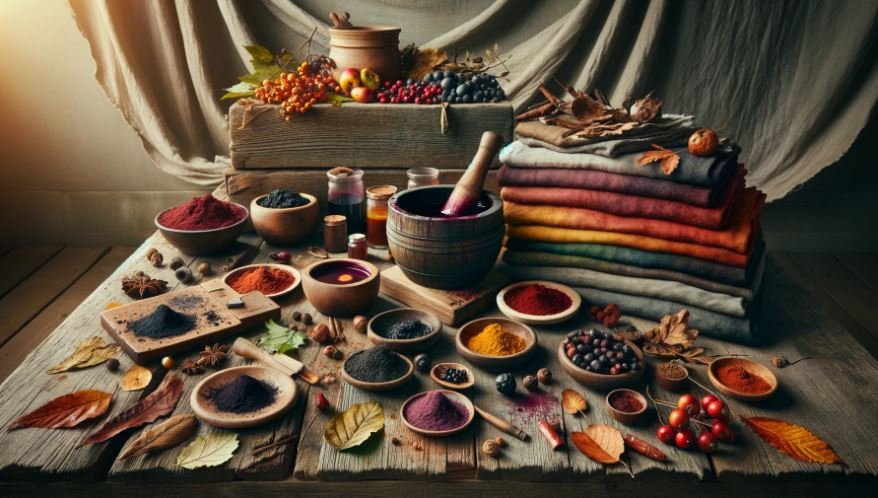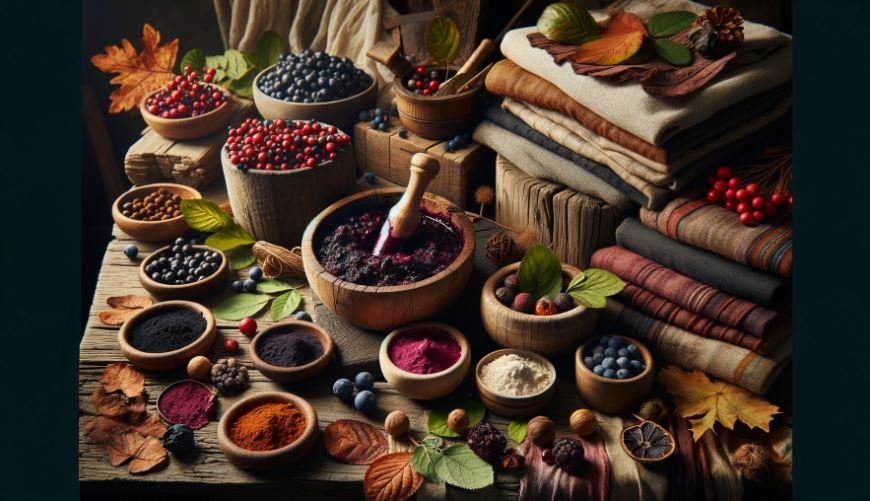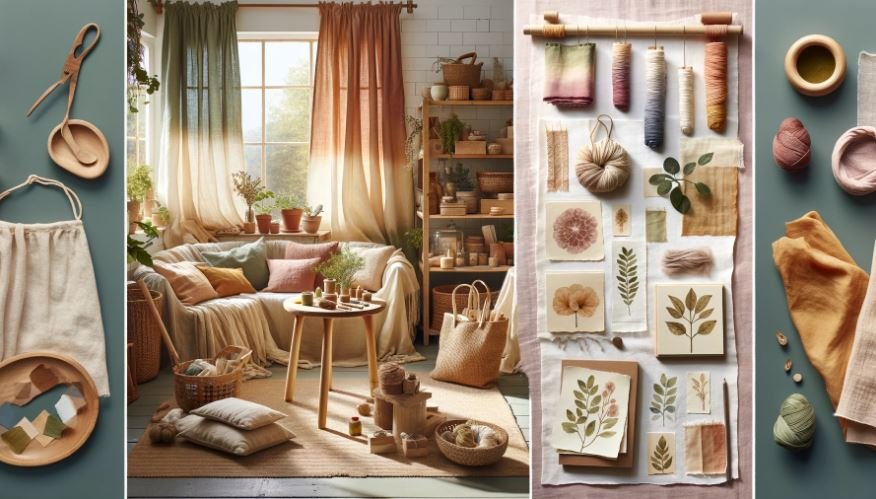DIY
How to Make Natural Dyes to Dye Fabric & Clothes at Home

Do you have a bunch of old, white clothes in your closet that are just asking to be colored? Or maybe you’re into crafts and want to find an eco-friendly way to make your own projects more colorful.
You don’t need to look any further! You will learn about the wonderful world of natural dyes in this blog post. We will also show you how to make your own at home and use them to make beautiful, one-of-a-kind clothes and fabrics.
Benefits and Uses of Natural Dyes in Textiles
Natural dyes are like a breath of fresh air in a world saturated with synthetic chemicals. They’re derived from plants, vegetables, fruits, and even some insects. What’s remarkable about natural dyes is that they not only infuse life into your textiles but also come with a host of other benefits:
Environmentally Friendly:
Natural dyes are non-toxic and biodegradable, making them a sustainable choice that won’t harm our planet.
Skin-Friendly:
These dyes are generally hypoallergenic and gentle on your skin, making them perfect for clothing items you wear every day.
Unique and Beautiful:
Natural dyes produce unique, subtle hues that can’t be replicated with synthetic dyes. Each batch tells a story.
Connecting with Nature:
Using natural dyes is a way to connect with the natural world, fostering a deeper appreciation for the environment.
Getting Started
Materials You’ll Need:
- White fabric or clothes
- Natural dye sources (we’ll explore some options shortly)
- Large pots
- Strainers
- Rubber gloves
- Wooden spoons
- String or rubber bands
- Mason jars or squeeze bottles
- Water
- A stove
- Natural Dye Sources
Here are a few common sources for natural dyes:
- Turmeric: Produces a stunning golden-yellow color.
- Beetroot: Yields a lovely pink or deep red hue.
- Blueberries: Create a soft blue or lavender tone.
- Onion Skins: Offer a range of warm, earthy colors.
- Spinach or Spinach Leaves: Give you vibrant green shades.
- Avocado Pits: These can surprise you with subtle pink and peachy hues.

Step-by-Step Guide
Step 1: Prepare Your Fabric
Wash your fabric or clothes to ensure they’re clean and ready to accept the dye.
Step 2: Prepare Your Dye
Chop, grate, or crush your chosen natural dye source.
Place the dye source in a pot and add water (approximately 2-3 cups of water per 1 cup of dye material).
Simmer for about an hour, stirring occasionally.
Step 3: Strain Your Dye
Use a strainer to separate the liquid dye from the solid material, creating a rich, concentrated dye.
Step 4: Dye Your Fabric
Wet your fabric in plain water and then immerse it in the dye bath.
Simmer on low heat for 30-60 minutes. Stir occasionally.
For lighter shades, reduce the dyeing time.
Step 5: Rinse and Dry
Rinse your dyed fabric thoroughly in cold water until it runs clear.
Let it air dry to reveal the final, beautiful shade.
Additional Tips
Experiment with different combinations of natural dyes to create unique colors.
Try different fabric materials, as they absorb dye differently.
Add salt or vinegar to your dye bath to enhance color retention.
Advanced Techniques in Shibori and Tie-Dye Fabric Dyeing
Now that you’ve mastered the basics of natural dyeing, take your skills to the next level by exploring the fascinating world of Shibori and tie-dye techniques. These methods are all about creating intricate and eye-catching patterns on your fabrics.
Shibori:
This ancient Japanese dyeing technique involves folding, binding, and manipulating the fabric to create captivating patterns. You can use traditional Shibori patterns or invent your own. Whether it’s the mesmerizing Kanoko Shibori or the striking Arashi Shibori, there’s a world of designs to explore.
Tie-Dye:
A beloved classic, tie-dye allows you to unleash your inner artist. Secure sections of your fabric with rubber bands, creating mesmerizing spirals, stripes, or intricate mandalas. Then, apply your natural dye to each section. The result? A vivid, psychedelic burst of colors that’s bound to turn heads.
Expanding Natural Dyes
While we’ve primarily focused on clothing and fabric, don’t forget that you can use natural dyes to add a touch of creativity to various aspects of your life:
Eco-Friendly Home Decor:
From dyeing curtains to throw pillows and tablecloths, you can infuse your home with a touch of nature’s charm. Your living space will be transformed into an oasis of color and comfort.
Personalized Gifts:
Imagine gifting your loved ones with hand-dyed, one-of-a-kind items. A scarf, a tote bag, or a set of napkins, dyed with love, will surely make your presents unforgettable.
DIY Art and Crafts: Expand your natural dyeing skills to paper, wood, and even your artwork. Experiment with botanical prints, creating stunning, nature-inspired masterpieces.

Eco-Friendly Coloring for a Sustainable Future
One of the most significant benefits of using natural dyes is their positive impact on the environment. Unlike their synthetic counterparts, natural dyes are derived from renewable resources, making them a sustainable choice for eco-conscious individuals. Here’s how your journey into natural dyeing can contribute to a greener, more sustainable future:
Reducing Chemical Pollution:
Conventional dyeing processes often involve the use of harmful chemicals, which can end up in our waterways, harming aquatic life and ecosystems. By using natural dyes, you can reduce the environmental footprint of your dyeing projects and help protect the planet’s water resources.
Supporting Local Farmers and Artisans:
Many natural dye sources are grown by local farmers and artisans, creating opportunities for sustainable livelihoods in communities around the world. When you choose to use natural dyes, you’re not just making a fashion statement; you’re also supporting small-scale agriculture and traditional crafts.
Celebrating Biodiversity:
Natural dyes are a celebration of biodiversity. The vibrant colors they produce are a testament to the rich tapestry of plant and insect life on our planet. By using natural dyes, you honor and respect the diverse flora and fauna that make our world so unique.
Connecting with Tradition:
Throughout history, cultures worldwide have used natural dyes for their textiles. Embracing natural dyeing techniques allows you to connect with and preserve these rich traditions. It’s a way of paying homage to the creativity and wisdom of our ancestors.
Promoting Slow Fashion:
The fast fashion industry is notorious for its negative environmental impact. By incorporating natural dyeing into your fashion choices, you contribute to the slow fashion movement, which emphasizes quality over quantity, durability over disposability, and craftsmanship over mass production.
Troubleshooting and Expert Tips
As you delve deeper into the world of natural dyeing, you might encounter a few challenges. Here are some expert tips to help you troubleshoot common issues:
Fading Colors:
To prevent fading, rinse your dyed fabrics with a mixture of water and vinegar or use a mordant (a substance that helps set the dye). Additionally, store your dyed items away from direct sunlight to prolong their vibrancy.
Uneven Dyeing:
Achieving even colors can be a challenge. Stir your dye bath consistently to ensure even distribution. You can also pre-soak your fabric in a mixture of water and vinegar to help the dye penetrate more evenly.
Color Variations:
Keep in mind that the natural world can be unpredictable, and variations in color are part of the charm of natural dyeing. Embrace the uniqueness of each piece you create.
Washing and Care: Be gentle with your dyed items. Hand wash them in cold water with mild detergent to preserve the colors. Avoid wringing, and air-drying to maintain the fabric’s integrity.
Begin Your Journey with Natural Dyeing Techniques
Natural dyeing isn’t just a do-it-yourself job; it’s a way to be creative, help the environment, and connect with nature. It’s a chance to change your home, your clothes, and your attitude. Get your materials together, choose your best natural dye sources, and get ready for a colorful adventure. There are a lot of different things you can do with natural colors, no matter how much experience you have or how interested you are in learning. Get ready to discover, try, and make your own beautiful, long-lasting works of art.
FAQs
Are natural dyes less vibrant than synthetic dyes?
A lot of different bright and rich colors can be made with natural dyes. Even though their colors aren’t as strong as fake ones, the beautiful, one-of-a-kind shades they offer are praised. How bright the color is relies on the fabric, the type of natural dye used, and the way it is dyed.
2. Are natural dyes safe for people with allergies or sensitive skin?
Yes, most natural dyes are safe for people with allergies and are gentle on the skin. Lots of people with allergies or sensitive skin like them because they are safe and feel good. But if you have certain allergies or sensitivities, you should put a small piece of dyed fabric on your skin first to see how it reacts.
3. Can I dye synthetic fabrics with natural dyes?
Cotton, linen, silk, and wool are some of the natural fibers that natural colors work best on. You can dye synthetic materials, but you might not be able to tell what will happen and the colors might not last as long or be as bright. Natural fibers and dyes tend to stick together better.
4. Do I need any special equipment to start natural dyeing at home?
No, you don’t need any special tools to start dying with plants. A lot of the things you need are likely to be around your house already, like pots, strainers, and wooden spoons. However, it is very important to have the right plants, fruits, or veggies that you plan to use as dye sources.
5. How can I make my natural dye colors last longer?
If you want your natural dye colors to last longer, you might want to use a mordant, which helps the dye set. You can also use a mixture of water and vinegar to rinse your dyed clothes before you wash them. Keeping dyed things out of direct sunlight is also important, since UV rays can fade colors over time. Finally, take care of your colored items the way the manufacturer tells you to, like washing them by hand in cold water and letting them dry naturally.
Conclusion
Not only is it fun and creative to make natural dyes at home, but it’s also an eco-friendly way to give your clothes and fabrics a new lease on life. Every dye bath is different, and the effects always surprise and please. So why not start this journey and use your closet to show how creative you are and how much you care about the environment? Now is the time to explore the wide range of natural colors available and use the beauty of nature to bring your clothes to life.
-

 Celebrity4 weeks ago
Celebrity4 weeks agoIs YNW Melly Out Of Jail? What Is The YNW Melly Release Date, Career, Early Life, And More
-

 Sports4 weeks ago
Sports4 weeks agoMore Than Just a Game: How College Sports Can Shape Your Future
-

 Tech3 weeks ago
Tech3 weeks agoAI Software: Transforming the Future of Technology
-

 Tech3 weeks ago
Tech3 weeks agoAll About Com. Dti. Folder Launcher: Features, Benefits, Tips, And More













